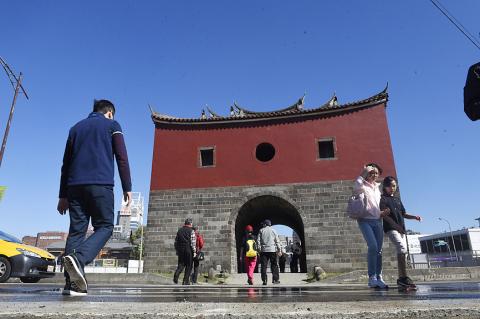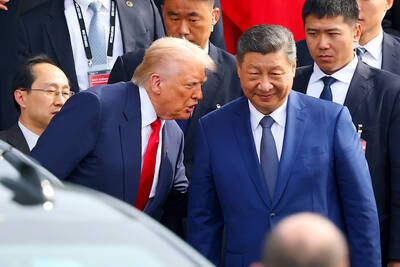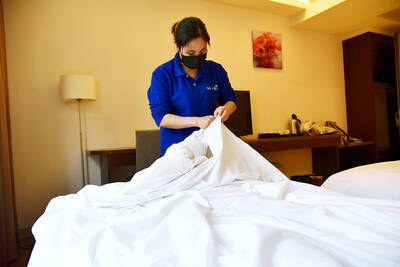Taipei’s Zhongxiao W Road was reopened to traffic yesterday morning after work to tear down an overpass to the Zhongxiao Bridge (忠孝橋) was completed ahead of schedule.
However, authorities advised commuters to depart at least 20 minutes earlier or to use public transportation if they are required to pass through the area on their way to work tomorrow morning.
Taipei Department of Transportation Commissioner Chung Hui-yu (鍾慧諭), Public Works Department Director Peng Chen-sheng (彭振聲), Traffic Division head Wu Yao-nan (吳耀南) and other officials used a whistle to signal the reopening before traffic resumed at 8am yesterday.

Photo: Tsung Chang-chin, Taipei Times
Peng said a steel structure is to be built by Nov. 30 to fill in a gap in the bridge after the overpass is demolished, but the Public Works Department is in talks with the construction’s contractor to move the completion date to July.
Once the structure is completed, the project is to enter its second phase, in which a bus station used by Kuo-kuang Motor Transportation Co (國光客運) is to be demolished.
As Zhongxiao W Road has been reduced from four lanes to three in each direction, people are advised to use public transportation or use the Jhongsing Bridge (中興橋) or Taipei Bridge (台北橋) when commuting to Taipei from New Taipei City, Chung said.
If traffic congestion extends to 3km, the department is to allow only large vehicles and motorcycles to directly exit from the Zhongxiao Bridge, while cars are to be directed through the Huanhe (環河) gateway, Chuang said, adding that if traffic backs up for 5km, cars are to be directed to the Jhongsing or Taipei bridges.
The department expects traffic in the area to stabilize after a week, she added.
Taipei Mayor Ko Wen-je (柯文哲) said he was satisfied with the demolition work being completed earlier than planned, adding that while work continues on the city’s west area gateway project, the overpass had accomplished its mission and Taipei’s North Gate (北門) is now once again visible, opening a new page in Taipei’s history.
“Good preparation is the reason the demolition was successful and ended sooner than planned,” Ko said, adding that the result could not have been accomplished without careful planning and precise execution.
He said his administration is following the mantra of “think slowly and act rapidly,” adding that he hopes the government can learn from the success to make the city better.
Additional Reporting by I-chia Lee

CALL FOR SUPPORT: President William Lai called on lawmakers across party lines to ensure the livelihood of Taiwanese and that national security is protected President William Lai (賴清德) yesterday called for bipartisan support for Taiwan’s investment in self-defense capabilities at the christening and launch of two coast guard vessels at CSBC Corp, Taiwan’s (台灣國際造船) shipyard in Kaohsiung. The Taipei (台北) is the fourth and final ship of the Chiayi-class offshore patrol vessels, and the Siraya (西拉雅) is the Coast Guard Administration’s (CGA) first-ever ocean patrol vessel, the government said. The Taipei is the fourth and final ship of the Chiayi-class offshore patrol vessels with a displacement of about 4,000 tonnes, Lai said. This ship class was ordered as a result of former president Tsai Ing-wen’s (蔡英文) 2018

UKRAINE, NVIDIA: The US leader said the subject of Russia’s war had come up ‘very strongly,’ while Jenson Huang was hoping that the conversation was good Chinese President Xi Jinping (習近平) and US President Donald Trump had differing takes following their meeting in Busan, South Korea, yesterday. Xi said that the two sides should complete follow-up work as soon as possible to deliver tangible results that would provide “peace of mind” to China, the US and the rest of the world, while Trump hailed the “great success” of the talks. The two discussed trade, including a deal to reduce tariffs slapped on China for its role in the fentanyl trade, as well as cooperation in ending the war in Ukraine, among other issues, but they did not mention

HOTEL HIRING: An official said that hoteliers could begin hiring migrant workers next year, but must adhere to a rule requiring a NT$2,000 salary hike for Taiwanese The government is to allow the hospitality industry to recruit mid-level migrant workers for housekeeping and three other lines of work after the Executive Yuan yesterday approved a proposal by the Ministry of Labor. A shortage of workers at hotels and accommodation facilities was discussed at a meeting of the legislature’s Transportation Committee. A 2023 survey conducted by the Tourism Administration found that Taiwan’s lodging industry was short of about 6,600 housekeeping and cleaning workers, the agency said in a report to the committee. The shortage of workers in the industry is being studied, the report said. Hotel and Lodging Division Deputy Director Cheng

TOKYO SUMMIT: The new Japanese PM’s words have demonstrated Japan’s ‘firm position on urging the prioritization of cross-strait peace,’ the foreign ministry said Minister of Foreign Affairs Lin Chia-lung (林佳龍) yesterday thanked US President Donald Trump and Japanese Prime Minister Sanae Takaichi for supporting peace in the Taiwan Strait, a day after the two at a summit in Tokyo emphasized the importance of regional stability and ahead of a meeting between Trump and Chinese President Xi Jinping (習近平) in South Korea today. The previous day’s meeting was the first time Takaichi had met with the US leader since becoming Japanese prime minister, the Ministry of Foreign Affairs said in a statement. Since taking office on Tuesday last week, Takaichi has urged the international community to